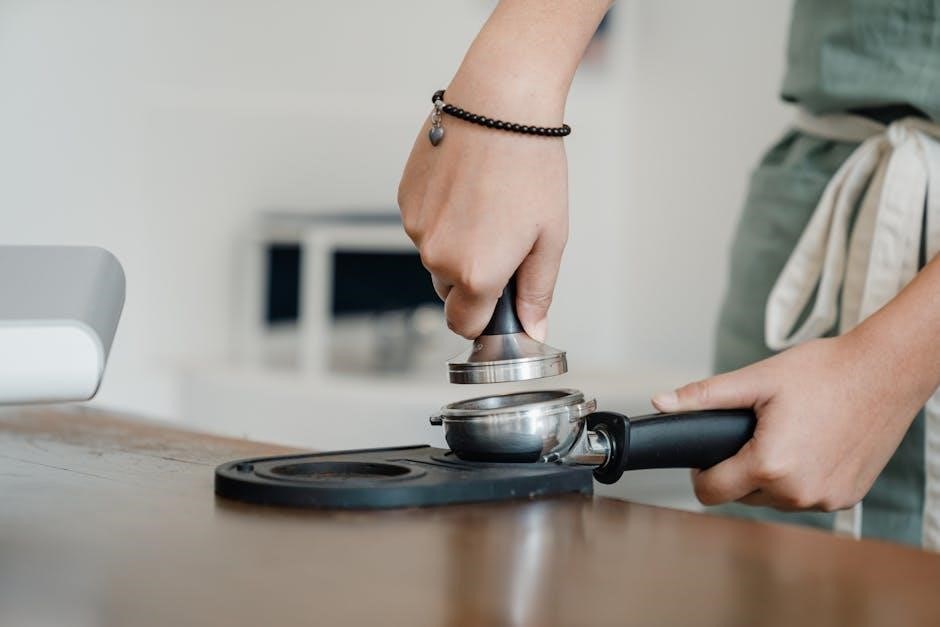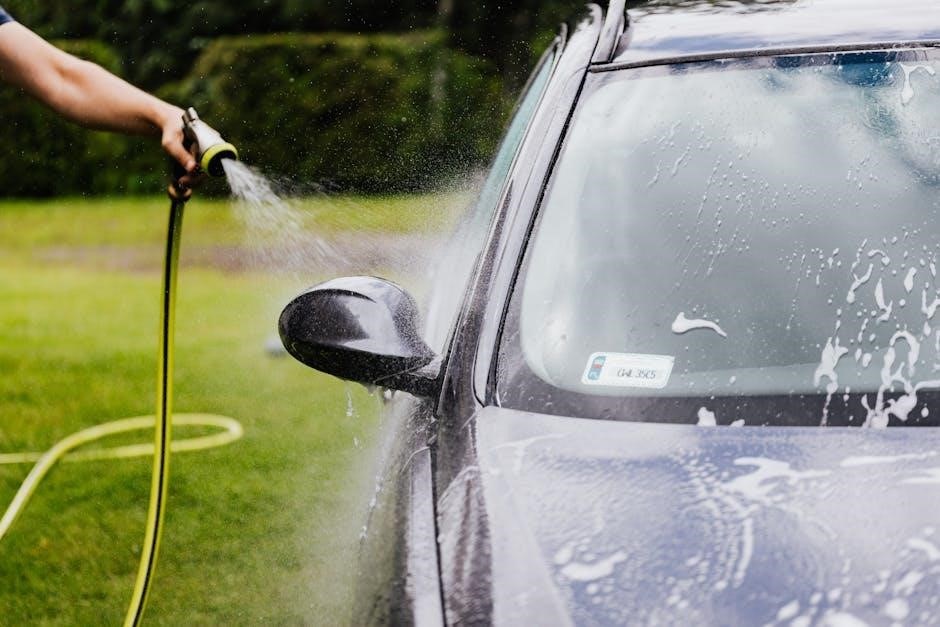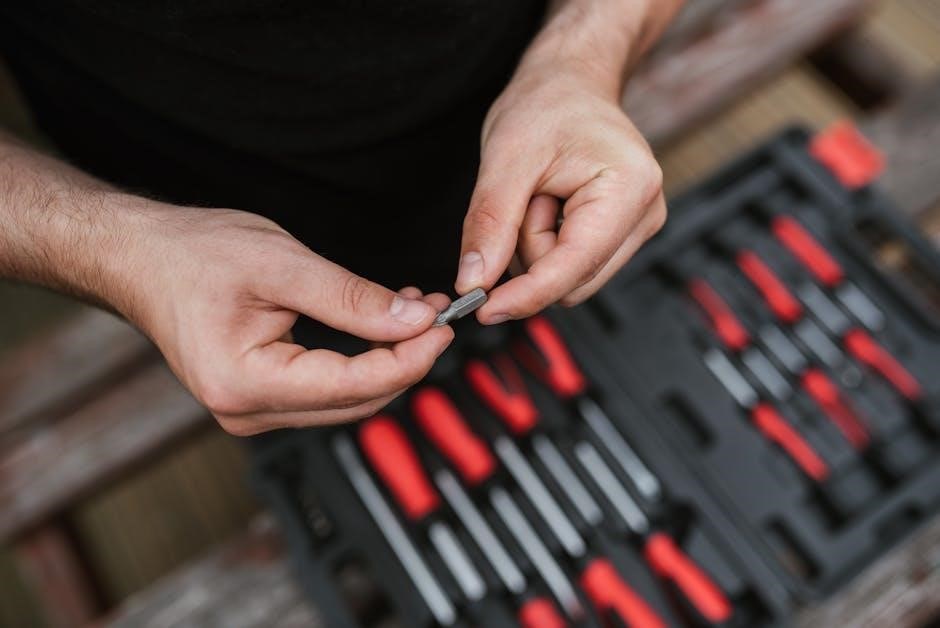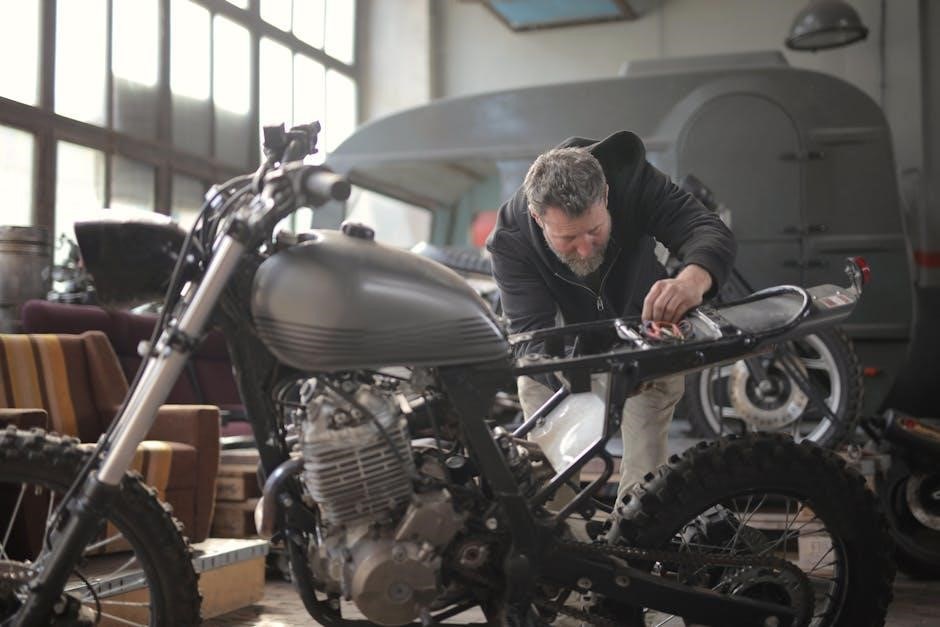The Sea-Doo Service Manual PDF is an essential guide for maintaining and repairing your watercraft. It provides detailed instructions, diagrams, and troubleshooting tips to ensure optimal performance and safety.
Overview of the Sea-Doo Service Manual
The Sea-Doo Service Manual is a comprehensive guide designed for owners and technicians to maintain and repair Sea-Doo watercraft. It covers various models, including GTS, GTi, RXT, GTX, and Wake series, providing detailed instructions for routine maintenance, diagnostics, and complex repairs. The manual includes maintenance schedules, repair procedures, and troubleshooting tips. It also offers insights into storage and winterization processes to ensure long-term performance. Available as a free PDF, it serves as an invaluable resource for anyone looking to service their Sea-Doo effectively.
Importance of Using the Service Manual
Using the Sea-Doo Service Manual is crucial for ensuring proper maintenance, repairs, and troubleshooting of your watercraft. It provides detailed instructions and safety guidelines, helping owners and technicians avoid costly errors. By following the manual, you can extend the lifespan of your Sea-Doo, improve performance, and reduce repair costs. It also helps identify potential issues early, preventing major breakdowns. The manual is an essential resource for anyone looking to keep their watercraft in optimal condition and ensure safe operation.
How to Download and Access the Sea-Doo Service Manual PDF
To download the Sea-Doo Service Manual PDF, visit the official Sea-Doo website or authorized dealers. Select your model year and type to access the correct manual. You can also find free PDF versions on trusted third-party sites. Once downloaded, open the PDF using a compatible reader. Ensure you have the latest version for accurate information. This manual is essential for proper maintenance, repairs, and troubleshooting, providing detailed guidance for optimal performance and safety of your Sea-Doo watercraft.

Understanding the Structure of the Sea-Doo Service Manual
The Sea-Doo Service Manual is organized into clear sections, covering maintenance, repairs, and troubleshooting. It includes detailed diagrams, step-by-step instructions, and essential specifications for optimal performance.
Table of Contents and Navigation
The Sea-Doo Service Manual PDF features a detailed table of contents, making it easy to locate specific sections. Categories include maintenance, repairs, and troubleshooting. Each chapter is further divided into sub-sections, such as routine checks, engine specifications, and electrical systems. Bullet points and clear headings guide users effortlessly. Visual aids like diagrams and quick-reference guides enhance navigation. This structure ensures users can quickly find the information they need, saving time and effort. The manual is designed for intuitive browsing, catering to both novice and experienced technicians.
Interpreting Diagrams and Illustrations
The Sea-Doo Service Manual PDF includes detailed diagrams and illustrations to guide users through complex procedures. These visuals are labeled with part numbers and descriptions, ensuring clarity. Color-coded components help differentiate between systems, while exploded views provide a clear understanding of assembly and disassembly. Symbols are used to represent actions like tightening or loosening. Always cross-reference diagrams with written instructions to avoid misinterpretation. Taking time to study these visuals ensures accurate repairs and maintenance, reducing the risk of errors. This visual guidance is essential for both novice and experienced technicians.
Maintenance and Repair Procedures
Regular maintenance ensures optimal performance and longevity of your Sea-Doo. Follow detailed procedures for routine checks, troubleshooting, and repairs, with step-by-step guidance for all skill levels.
Daily and Routine Maintenance Checklist
A daily and routine maintenance checklist is essential for ensuring your Sea-Doo operates safely and efficiently. Begin with pre-ride checks: inspect fuel levels, oil levels, and coolant. Check battery terminals, throttle cable, and steering for proper function. Inspect propellers and the jet pump for damage or debris. Routine tasks include oil changes, spark plug replacements, and air filter cleaning. Refer to the manual for specific intervals, such as every 50 hours for oil changes and 100 hours for cooling system flushing. Regularly inspect the hull and trailer for damage or wear. Always follow manufacturer guidelines to prevent warranty voidance and ensure reliability. Keep a record of all maintenance activities for future reference.
Step-by-Step Guide to Common Repairs
A step-by-step guide to common repairs helps you address issues efficiently. Start by identifying the problem using the manual’s troubleshooting section; Gather the necessary tools and parts before beginning. For example, repairing a faulty ignition switch involves disconnecting the battery, removing the switch, and installing a new one. Always follow the manual’s specific instructions for your model. For complex tasks like engine oil leaks or electrical faults, consult detailed diagrams and procedures. Ensure proper waste disposal for hazardous materials. Safety is paramount, so avoid shortcuts and seek professional help if unsure.
Tools and Equipment Required for Service
Servicing your Sea-Doo requires specific tools and equipment. Essential items include wrenches, screwdrivers, pliers, and a multimeter for electrical diagnostics. Specialized tools, like a spark plug wrench and propeller puller, are necessary for engine and drivetrain work. Safety gear, such as gloves and goggles, is crucial for protection. Refer to the manual for a detailed list tailored to your model. Proper tools ensure accurate repairs and prevent damage to your watercraft. Always use high-quality, compatible equipment for optimal results.

Safety Precautions and Guidelines
Adhering to safety guidelines is crucial when servicing your Sea-Doo. Always wear protective gear, ensure proper ventilation, and handle hazardous materials with care. Disconnect the battery before starting repairs to avoid accidental startups. Use approved tools and follow manual instructions to minimize risks. Keeping a fire extinguisher nearby and avoiding loose clothing can prevent accidents. Safety should always be your top priority to ensure a successful and injury-free service experience.
Essential Safety Measures Before Starting Repairs
Before beginning any repairs, ensure the Sea-Doo is on a stable surface and the engine is cool. Disconnect the battery to prevent accidental startups and avoid potential electrical shocks. Wear protective gear, including gloves and safety glasses, to safeguard against injury. Check for any fuel or coolant leaks and ensure proper ventilation to avoid inhaling harmful fumes. Consult the manual for specific precautions related to your model and always follow recommended safety protocols to minimize risks during the repair process.
Handling Hazardous Materials and Waste
When servicing your Sea-Doo, handle hazardous materials like oil, fuel, and coolant with care. Always wear protective gloves and eyewear to prevent exposure. Store these materials in sealed containers to avoid spills. Dispose of waste according to local regulations; never drain fluids into waterways or soil. Use absorbent pads for spills and ensure good ventilation. Refer to the manual for specific disposal guidelines and environmental precautions to minimize ecological impact and ensure compliance with safety standards.
Emergency Procedures and First Aid
In case of an emergency, remain calm and act quickly. Assess the situation and ensure personal safety. For severe injuries, stabilize the affected area and seek immediate medical attention. Minor cuts or burns should be cleaned with antiseptic wipes and covered. Keep a first aid kit onboard, including bandages, gloves, and antiseptic solutions. For chemical exposure, flush the area with water and remove contaminated clothing. Prevent further harm by isolating the source of the hazard. Always prioritize professional medical care for serious incidents.

Troubleshooting Common Issues
Identify symptoms, use diagnostic tools, and consult the manual for detailed solutions. This section helps pinpoint common issues and prevent further damage efficiently.
Identifying and Diagnosing Problems
Early detection of issues is crucial for maintaining your Sea-Doo’s performance. The manual provides detailed symptom charts and diagnostic procedures to help identify problems quickly. Start by analyzing symptoms like unusual noises, decreased performance, or warning lights. Use diagnostic tools like error code readers or compression testers to pinpoint faults. Cross-reference findings with the manual’s troubleshooting charts to narrow down potential causes. This systematic approach ensures accurate diagnoses, preventing unnecessary repairs and saving time. Always follow the manual’s guidelines for safe and effective problem-solving.
Common Faults and Their Solutions
The Sea-Doo Service Manual highlights frequent issues and their fixes. Spark plug fouling is common; clean or replace plugs as needed. Faulty ignition coils can cause misfires; test and replace if necessary. Intake manifold leaks may occur; inspect and seal connections. Additionally, defective sensors often trigger error codes; replace sensors if testing reveals malfunctions. Addressing these issues promptly ensures optimal performance and prevents further damage; Regular inspection and timely repairs are key to maintaining reliability and extending the lifespan of your Sea-Doo.
- Spark plug fouling: Clean or replace plugs.
- Ignition coil failure: Test and replace if faulty.
- Intake manifold leaks: Inspect and seal connections.
- Defective sensors: Replace if testing confirms issues.
Using Diagnostic Tools and Techniques
The Sea-Doo Service Manual emphasizes the use of diagnostic tools like BUDS (Bombardier Utility and Diagnostic System) and DDEC (Detroit Diesel Electronic Controls) for accurate troubleshooting. Technicians can retrieve error codes, monitor live data, and perform system tests. Visual inspections, compression tests, and multimeter use are also essential. Always follow the manual’s step-by-step diagnostic procedures to identify issues efficiently; Proper use of these tools ensures precise repairs and minimizes downtime.
- Use BUDS or DDEC for error code retrieval and live data analysis.
- Perform compression and electrical tests with appropriate tools.
- Follow manual-guided diagnostic procedures for accuracy.

Engine-Specific Information
The Sea-Doo Service Manual provides detailed insights into engine types, including Rotax 2-stroke and 4-stroke engines, emphasizing performance and efficiency.
- Covers engine configuration and fuel injection systems.
- Details cooling and lubrication systems for optimal performance.
2-Stroke Engine Maintenance and Repair
The Sea-Doo Service Manual provides comprehensive guidance on 2-stroke engine maintenance, emphasizing routine checks and replacements to ensure optimal performance. Key areas include fuel system cleaning, exhaust system inspection, and lubrication system verification. The manual also details troubleshooting for common issues like overheating or reduced power output. Detailed repair procedures are outlined, along with torque specifications and recommended tools. Regular maintenance intervals are highlighted to prevent wear and tear, ensuring longevity and reliability of the engine. Follow the manual for DIY-friendly solutions and professional-level care. Always adhere to safety guidelines during repairs. Proper maintenance is crucial for maintaining performance and efficiency.
4-Stroke Engine Service and Overhaul
The Sea-Doo Service Manual details 4-stroke engine service, including oil changes, filter replacements, and valve clearance adjustments. Regular maintenance ensures smooth operation and prevents premature wear. Overhaul procedures are outlined for piston, cylinder, and crankshaft replacement. Detailed torque specifications and reassembly steps are provided. Proper tool usage is emphasized to avoid damage. Follow the manual’s guidelines for routine inspections and repairs to maintain engine performance and longevity. Adhering to service intervals is critical for reliable operation and extending the engine’s lifespan. Always use genuine parts for optimal results.
Rotax Engine Specifications and Care
The Sea-Doo Service Manual provides detailed specifications for Rotax engines, including displacement, horsepower, and torque ratings. Proper care involves regular oil changes, coolant checks, and spark plug replacements. The manual emphasizes maintaining correct fluid levels and using genuine Rotax parts. Routine inspections of the intake system and exhaust are crucial to prevent damage. Adhering to the recommended service intervals ensures optimal performance and extends engine life. Always follow the manual’s guidelines for specific Rotax models to maintain reliability and power output. Regular maintenance is key to preserving your Sea-Doo’s engine health.

Transmission and Drivetrain
The Sea-Doo Service Manual details transmission and drivetrain maintenance, including gear inspection, bearing lubrication, and driveshaft alignment. Regular checks ensure smooth operation and prevent wear. Use genuine parts for repairs.
Transmission Maintenance and Repair
The Sea-Doo Service Manual provides detailed steps for transmission maintenance, including fluid level checks, gear inspection, and bearing lubrication. Regular inspection of drive belts and shafts is crucial to prevent wear. For repairs, the manual outlines disassembly and reassembly procedures, emphasizing the use of specialized tools. Replacing worn or damaged components with genuine Sea-Doo parts ensures optimal performance and longevity. Always refer to the manual for torque specifications and safety guidelines during transmission servicing.
Drivetrain Components and Lubrication
The Sea-Doo Service Manual details the drivetrain components, including driveshafts, bearings, and couplers. Regular lubrication of these parts is essential to prevent corrosion and wear. The manual specifies the recommended grease types and application intervals. Inspect driveshaft alignment and coupling condition to ensure smooth operation. Proper lubrication enhances durability and performance, while neglecting it can lead to premature component failure. Always follow the manual’s guidelines for drivetrain maintenance to maintain your Sea-Doo’s reliability and efficiency.
Propeller and Jet Pump Service
Regular inspection and maintenance of the propeller and jet pump are crucial for optimal performance. Inspect the propeller for damage or imbalance and clean debris from the jet pump regularly. Use specified tools to remove and reinstall components. Apply marine-grade grease to moving parts. Follow the service manual’s guidelines for propeller balancing to ensure smooth operation. Proper servicing extends component lifespan and maintains watercraft efficiency. Always refer to the manual for specific torque values and reassembly procedures to prevent damage or safety hazards.

Electrical and Electronic Systems
Understand the wiring diagrams, circuit layouts, and sensors. Troubleshoot faults using diagnostic tools. Replace faulty components following manual guidelines. Ensure proper connections and voltage levels.
Understanding the Electrical System
The Sea-Doo service manual provides detailed insights into the electrical system, including wiring diagrams, circuit layouts, and component functions. It explains how the system powers essential components like the ECU, sensors, and ignition. The manual covers battery maintenance, voltage checks, and troubleshooting common electrical faults. Understanding this section helps riders identify and repair issues efficiently, ensuring optimal performance and safety. It also highlights the importance of proper connections and grounding to prevent system malfunctions.
Troubleshooting Electrical Issues
The Sea-Doo service manual dedicates a section to diagnosing electrical system faults, offering step-by-step solutions for common issues like no power, intermittent operation, or component failure. It provides guidance on using multimeters to test voltage and continuity, ensuring accurate diagnoses. The manual highlights inspecting wiring harnesses for damage, corrosion, or loose connections—key issues in marine environments. By following the troubleshooting flowcharts and wiring diagrams, riders can isolate faults and address them effectively, restoring electrical functionality and preventing further complications.
Upgrading or Replacing Electrical Components
Upgrading or replacing electrical components in your Sea-Doo requires careful planning and adherence to the service manual. Always use genuine Sea-Doo parts to ensure compatibility and reliability. The manual provides detailed instructions for swapping components like sensors, ignition systems, or electronic control units. Proper grounding and connections are emphasized to prevent electrical interference. Before any replacement, disconnect the battery and ensure the system is discharged. Follow torque specifications and wiring diagrams to maintain system integrity and performance. Regularly inspect connectors for corrosion or damage to avoid future issues.

Fuel and Cooling Systems
The section covers fuel system maintenance, cooling system service, and fuel injection calibration. It ensures optimal engine performance and prevents overheating or fuel flow issues.
Fuel System Maintenance and Cleaning
Regular fuel system maintenance ensures optimal performance and prevents corrosion. Inspect and replace fuel filters as specified in the manual. Check for contamination or water in the fuel tank and clean it if necessary. Use a fuel system cleaner to remove debris and deposits from fuel lines and injectors. Always use the recommended fuel type to avoid engine damage. Draining old fuel before storage is crucial to prevent degradation. Follow the manual’s guidelines for cleaning and servicing to maintain your Sea-Doo’s fuel system in top condition.
Cooling System Service and Repair
Regular cooling system maintenance is vital to prevent overheating and engine damage. Inspect hoses for cracks or damage and replace them as needed. Clean the cooling passages and water intake screens to ensure proper water flow. Check the coolant level and mix ratio, using the recommended antifreeze to prevent corrosion. Replace the coolant every 2 years or as specified. Use a pressure test kit to identify leaks in the cooling system. Always follow the manual’s guidelines for servicing and repairing the cooling system to maintain your Sea-Doo’s performance and longevity.
Fuel Injection System Calibration
Fuel injection system calibration ensures optimal engine performance and fuel efficiency. Use the BUDS terminal or authorized diagnostic tools to adjust settings. Calibration is typically required after installing new components or updating engine software. Refer to the Sea-Doo service manual for precise procedures. Always follow factory specifications to avoid engine damage. Proper calibration maintains power delivery, reduces emissions, and prevents issues like rough idle or poor acceleration. This process should only be performed by trained technicians or experienced users with the correct tools.

Storage and Winterization
Proper storage and winterization protect your Sea-Doo from damage. Clean, drain, and protect the engine. Lubricate moving parts and secure the vehicle. Ensure reliability next season.
Preparing Your Sea-Doo for Storage
Before storing your Sea-Doo, clean the exterior and interior thoroughly. Drain the fuel tank or stabilize the fuel to prevent degradation. Flush the cooling system and lubricate all moving parts. Disconnect the battery and store it in a cool, dry place. Cover the vehicle with a breathable cover to protect it from dust and moisture. Ensure all compartments are dry to avoid mold and mildew. Follow the manual’s specific guidelines for long-term storage to maintain your watercraft’s condition and performance.
Winterization Procedures
Winterizing your Sea-Doo prevents damage from freezing temperatures. Drain the engine cooling system and replace with antifreeze rated for -50°F. Fog the engine with a rust-inhibiting oil and change the oil filter. Disconnect and charge the battery, storing it in a cool, dry place. Flush the jet pump and exhaust system, then spray with corrosion protectant. Follow the manual’s winterization checklist to ensure all systems are protected. Proper winterization extends the life of your watercraft and ensures reliable performance when you return to the water.
Spring Maintenance After Storage
After winter storage, inspect your Sea-Doo for damage or wear. Recharge the battery and test electrical systems. Check oil levels and filters, replacing as needed. Inspect the cooling system for leaks or corrosion. Flush the fuel system and ensure the tank is clean. Test the throttle and steering for smooth operation. Perform a trial run in calm water to ensure everything functions properly. Address any issues before the riding season begins to guarantee optimal performance and safety.

Additional Resources and Support
Explore online forums, authorized dealers, and official support channels for additional guidance. Visit the manufacturer’s website for comprehensive resources, updates, and expert tips.
Online Communities and Forums
Join online forums and communities dedicated to Sea-Doo enthusiasts. These platforms offer valuable insights, troubleshooting tips, and real-world experiences from experienced riders and technicians. Many forums host detailed discussions on repairs, modifications, and maintenance, complementing the official service manual. Additionally, users often share downloadable resources, such as DIY guides and troubleshooting checklists, to help others resolve common issues. Participating in these communities can provide personalized advice and solutions tailored to specific Sea-Doo models and scenarios.
Authorized Service Centers and Dealers
Authorized Sea-Doo service centers and dealers are essential resources for professional maintenance and repairs. These certified experts use genuine parts and follow procedures outlined in the service manual to ensure compliance with manufacturer standards. They also provide warranty services and specialized tools for complex repairs. Visit the official Sea-Doo website to locate your nearest authorized dealer. Their expertise complements the manual, offering personalized support and ensuring your watercraft operates at peak performance with proper diagnostics and maintenance.
Third-Party Repair and Modification Guides
Third-party repair and modification guides offer alternative solutions for Sea-Doo enthusiasts seeking unique customizations or cost-effective fixes. These guides often include DIY tutorials and aftermarket parts, catering to users who prefer hands-on modifications. However, they may not align with official Sea-Doo standards, potentially voiding warranties or causing safety risks. Always exercise caution, as unofficial modifications can lead to performance issues. Ensure any third-party advice is cross-referenced with the official service manual for accuracy and safety compliance.
The Sea-Doo Service Manual PDF is an essential guide for maintaining and repairing your watercraft. Regular maintenance ensures safety, performance, and longevity. Follow the manual closely.
Final Tips for Using the Service Manual Effectively
To maximize the benefits of the Sea-Doo Service Manual PDF, always follow the recommended procedures and safety guidelines. Regularly update your manual for the latest information. Use the table of contents or index to quickly locate specific sections. Double-check torque specifications and critical bolt locations before reassembly. Refer to diagrams and illustrations for visual guidance. Gather all necessary tools and parts before starting a task. Keep your workspace clean and organized to avoid losing small components. By adhering to these tips, you’ll ensure efficient and safe servicing of your Sea-Doo.
Best Practices for Long-Term Maintenance
For long-term maintenance, prioritize regular inspections of the hull, engine, and electrical systems. Adhere to the service schedule outlined in the manual to prevent wear and tear. Lubricate moving parts and flush the cooling system seasonally. Store your Sea-Doo in a dry, protected area during off-seasons. Avoid aggressive riding habits that strain the engine. Keep records of all maintenance activities for future reference. By following these practices, you’ll extend the lifespan and performance of your Sea-Doo, ensuring reliability and safety on the water.